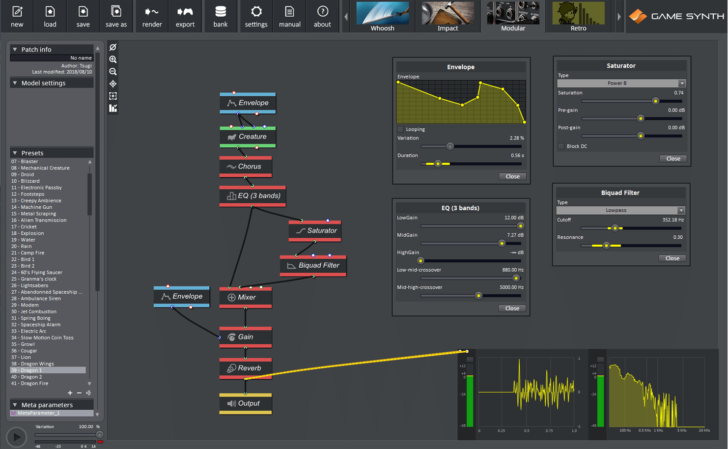Tsugi has introduced GameSynth 2022, a major update to their Windows procedural sound design tool for games and animation.
GameSynth offers many specialized synthesizers for generating sound effects: impacts, whooshes, footsteps, engines, particle-based sounds, environmental sounds, voice effects and more. It also provides a patching environment to build sound effects synthesizers by connecting 130+ modules together.
They say that GameSynth 2022 has been leveled up to be bigger, faster & smarter. Here’s what’s new:
- Bigger:
- 1000+ sound models of all types and styles in the repository.
- 15 new modules in the patching environment: Horn, Parametric, Stutter, Wavefolder, Drifter etc…
- New LFO shapes, Noise types, Formant parameters and more.
- 8 new effect racks in Voice FX: Clipper, Comb Filter, Frequency Shifter, Limiter, Resonator, Spectral Delay, Stutter, and Tube.
- Import of SVG drawings and new scripting functions in the Sketch Pad.
- New audio exporters (GameMaker Studio, Audacity).
- New animation curve importers (GameMaker Studio, Live2D).
- Faster:
- New module selector to quickly add modules by type, name, status etc…
- Partial playback to instantly check audio signals going through wires.
- New wire context menu to speed up patching.
- Snap wiring and automatic modules reconnection.
- Automatic .wav rendering for different meta-parameter values.
- Updated automatic export to game middleware (Wwise, FMOD…)
- Smarter:
- AI-powered perceptual map to find similar sound models.
- Audio analysis to find sound models close to a wave file.
- Patch search based on the modules used.
- Improved random patch creator.
- Variation detection in the run-time exporter
Pricing and Availability
GameSynth 2022 is available at the introductory price of US $273 (30% off, regular price $390) until the 30th of April, or as a free update for current users. Windows only.


is this related to audio-mulch?
it looks like an updated version
The focus in GameSynth is really on sound effects and procedural audio. They have tons of very specific synthesis algorithms and features that you would not find in audio-mulch, or in any other program for that matter.
I guess the only similarity really is it’s a node system, but you could say that from a lot of other tools too.
yes node systems are in everything these days…. but this is almost identical to the old audio-mulch UI from like 20 years ago
Actually it’s very different in terms of capabilities. And the UI you see for the patching environment is only one of about 10 synths… all pretty unique. Also, I just realized it’s a very old picture for some reason, like from several versions ago?!?
Terrible products, my worst purchase of last year by a mile (out of over a dozen VSTs) it was the DSP Motion and the other one, I cannot even recall. I installed them and after 5 minutes I asked for a refund because the quality and usability was not there. Never heard back.
Cannot recommend to anyone.
What are you talking about mate? DSP Motion is absolutely fantastic, our whole team loves it. And their support is top notch, like described somewhere else on this site.
Well to each its own I guess… I’ve been around the game audio business for almost a decade, and to my ears, in my professional opinion, they are a cool-ish gimmicks, not a professional tool for sound design.
If you want the professional version of those, get Reformer(Pro) and Traveller/GRM-Doppler to work together and you can make also your own textures. Alternatively give Sound Particles a go.
My luck with their support was very different. I report my experience, you report yours.
Admin: Multiple comments deleted. It appears that you are using multiple user names to post responses on the site:
Benjamin G, Jean Lapointe, Alex, Axel, Sylvain Verrand, etc.
Using a consistent identify for yourself will avoid your comments being treated as spam.
Lol I wonder who would go through the trouble of making multiple used names to support a product… Thank you for proving my point.
Also I googled Jean Lapointe, you and your “team” are nowhere to be found in the sound industry.
+1 for DSP Motion, this tool is incredible. Zeta, this is not a plug-in, so you may be thinking about something else. It’s also not something you can try in less than 5 minutes. Especially the first time, as it is so addictive to draw your sounds!
Glad you guys seem to find a use for it, to me it really does not sound good or I see a professional use for it. So I am not gonna lie about it. And you’re right, I forgot it was a stand alone not a VST!
tbf i agree but i use it for source material to layer and manipulate, it is absolutely terrible on its own but its actually fantastic when layering/manipulating with other sources. I love generating a shitload of variations and being able to time the modulations to animations and stuff. The products are kinda janky but theyve been updating them a ton and I am often very impressed. I think the smaller products like DSP motion/action etc are better because they are much faster and simpler and are finely tuned algorithms. Gamesynth is like, too complicated to be useful in a productive sense unless you wanna nerd out for awhile and make your own algorithms. It’s cool tho.
Looks amazing, really smart use of tech. It’s really important for game designers that every footstep sounds subtly different etc. so physical modelling like this is key. Love the use of AI to automatically match models to stamp led sounds!
But why Windows only? They should code this in JUCE.